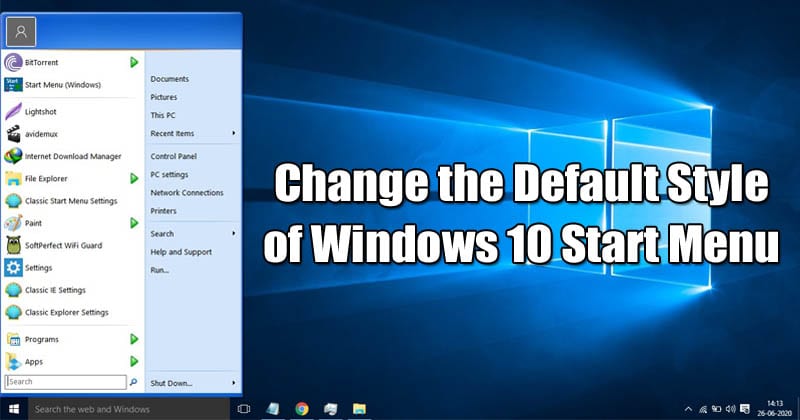

- #CUSTOMIZE WINDOWS 10 START MENU TASK SEQUENCE SOFTWARE#
- #CUSTOMIZE WINDOWS 10 START MENU TASK SEQUENCE CODE#
- #CUSTOMIZE WINDOWS 10 START MENU TASK SEQUENCE ISO#
The article talks about using group policy or Intune to deploy it – but if we only want it set as the default – and allow users to change it, use the same old way that we did with windows 10 task sequence Its the same old xml file we used in win 10 – but the “start” section is ignored – and the taskbar section is still used. The Win 11 taskbar is managed in the same way the Win 10 taskbar is, via an xml Here is a site which already has the reg entries you need listed – Īt least these settings are easy to manage – and there are even CSP’s for them – In order to keep things consistent, this is configured at a machine level via the registry keys at HKLM\SOFTWARE\Microsoft\PolicyManager\current\device\Start\AllowPinnedFolderDocuments, AllowPinnedFolderDownloads etc Since this isnt complex enough – another section has been added to the start menu – called “start folders” xcopy “start.bin” “C:\Users\Default\AppData\Local\Packages\_cw5n1h2txyewy\LocalState\” /y.The use a command such as the following in our TS.copy out “%LocalAppdata%\Packages\_cw5n1h2txyewy\LocalState\start.bin” to our SCCM package source.Customise the start menu as we want it to look.copy-item '\\MDTServer\MDTDS\Scripts\StartLayoutMenu.xml' 'C:\Windows\Temp'. NOTE: Ensure the StartMenuLayout.xml file sits in the Scripts folder along with this Copy Script. In order to customise this for the default user in a TS, we can 1.This is the Copy PS script used in MDT to copy this file to C:\Windows\Temp. Select the option to Extract a specific image index from the specified WIM file.Then select the Image index from the drop-down list.Click Next.
#CUSTOMIZE WINDOWS 10 START MENU TASK SEQUENCE ISO#
Initially thought this may be an anti-tamper measure but the file can be swapped across installs. In Data Source, click Browse and specify the network shared path to the install.wim from the Windows 10 Source directory where you extracted the source of an ISO file. Turns out the Windows 11 start menu stores its persistent state in an AES CBC PKCS7 encrypted JSON whose crypto input parameters feature a salt that utilizes Mersenne Twister PRNG. The start menu is now a json file stored under “%LocalAppdata%\Packages\_cw5n1h2txyewy\LocalState” – and appears to be encrypted to a level well past my understanding – so it not manually editable… (after all, what enterprise admin would want to control their users start menu right?!?!) Start menu and taskbar config is now 3 different configuration settings group: Defines to which group the task belongs.Following on from the dumpster fire that is Windows 10 start menu and taskbar configuration – The win 11 team have really stepped up and made this even worse… why? because “fuck you thats why” seems to be the best explanation.Will be used instead of the default properties when the command is executed on the Windows operating system. windows: Any Windows specific properties.command: The actual command to execute.If process is specified, the command is interpreted as a process to execute. If shell is specified, the command is interpreted as a shell command (for example: bash, cmd, or PowerShell).
#CUSTOMIZE WINDOWS 10 START MENU TASK SEQUENCE SOFTWARE#
Log on to a Windows 10 machine that has all of the software you want to be pinned on the Start Menu layout and customise the Start Menu as you want it. For a custom task, this can either be shell or process. The first thing we need to do is setup what we want our Start Menu to look like and export it. label: The task's label used in the user interface.The task's properties have the following semantic: Now create a HelloWorld.ts file with the following content function sayHello ( name : string ): void
#CUSTOMIZE WINDOWS 10 START MENU TASK SEQUENCE CODE#
Let's start with a simple "Hello World" TypeScript program that we want to compile to JavaScript.Ĭreate an empty folder "mytask", generate a tsconfig.json file and start VS Code from that folder. It is not available when editing single files. Note: Task support is only available when working on a workspace folder. vscode folder for a workspace.Įxtensions can also contribute tasks using a Task Provider, and these contributed tasks can add workspace-specific configurations defined in the tasks.json file. Workspace or folder specific tasks are configured from the tasks.json file in the. Tasks in VS Code can be configured to run scripts and start processes so that many of these existing tools can be used from within VS Code without having to enter a command line or write new code. Given their importance in the development life cycle, it is helpful to be able to run tools and analyze their results from within VS Code. These tools are mostly run from the command line and automate jobs inside and outside the inner software development loop (edit, compile, test, and debug). Examples include the TypeScript Compiler, linters like ESLint and TSLint as well as build systems like Make, Ant, Gulp, Jake, Rake, and MSBuild. Lots of tools exist to automate tasks like linting, building, packaging, testing, or deploying software systems.


 0 kommentar(er)
0 kommentar(er)
